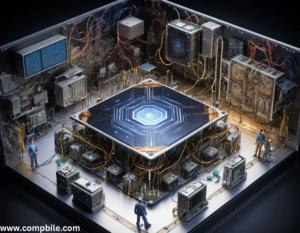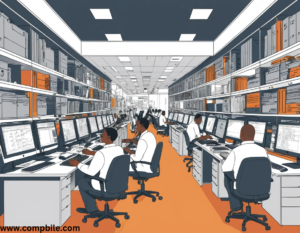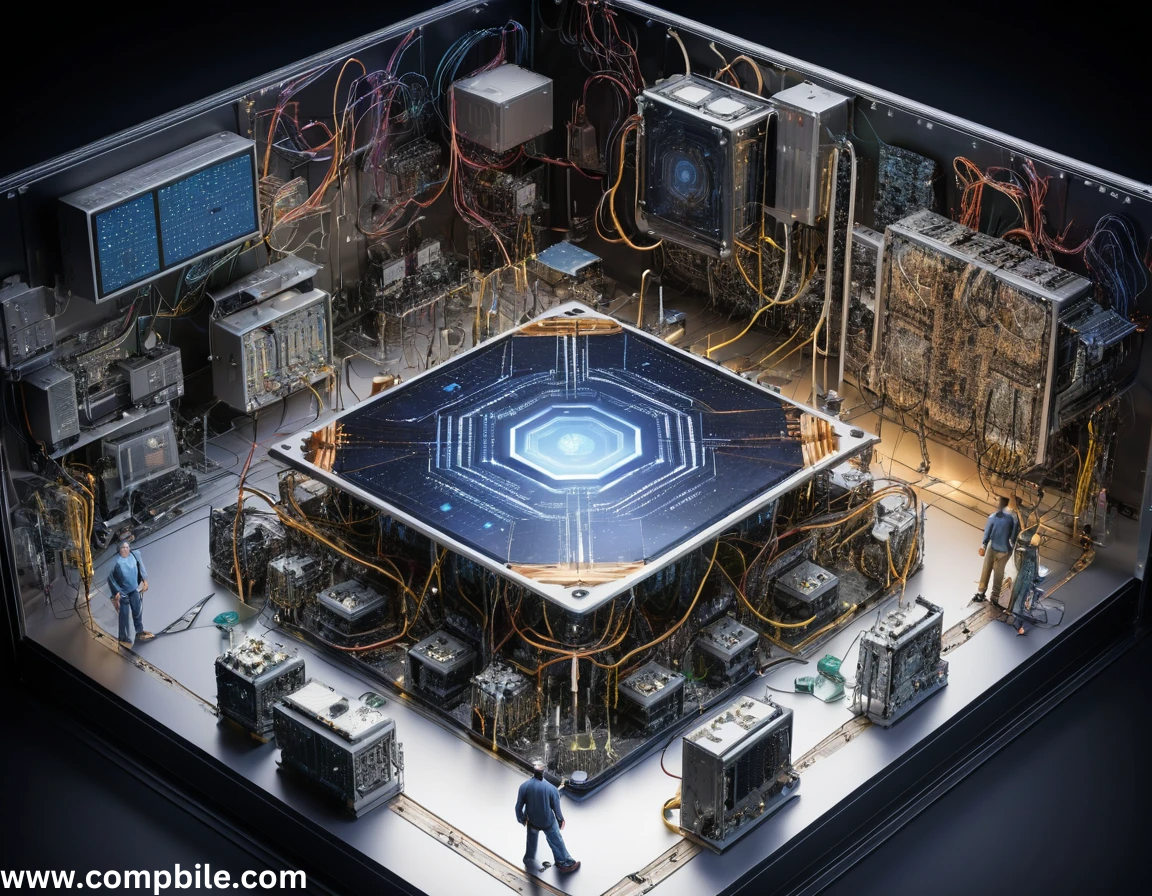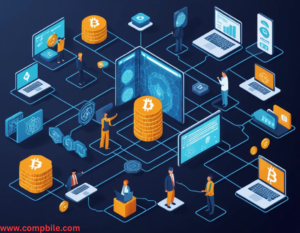computer model 2025Quantum Computing: Quantum computing is still in its early stages, but by 2025, we can expect some breakthroughs. Companies like IBM, Google, and startups are working on improving qubit coherence and error correction. This could lead to specialized quantum processors being used for tasks like optimization, material science, cryptography, and more.
- AI-Optimized Chips: Graphics Processing Units (GPUs) and other specialized processors like TPUs (Tensor Processing Units) will continue to dominate computing, especially with the rapid rise in AI-driven applications. These chips will be more energy-efficient, faster, and optimized for deep learning and large-scale AI tasks.
- ARM-based Architectures: ARM-based processors are gaining popularity in both personal computers and servers (think Apple’s M-series). By 2025, these chips could become the dominant architecture across various computing devices due to their energy efficiency and high performance.

2. Personal Computing Devices
- Foldable and Flexible Displays: We can expect more foldable or roll able screens in consumer laptops, tablets, and smartphones, making devices more portable and adaptable.
- AI-Powered Devices: Personal computers, smartphones, and tablets will increasingly leverage AI to enhance user experiences. Smart assistants, predictive processing, and personalized content delivery will become more seamless and integrated into everyday tasks.
- Immersive VR/AR Devices: Virtual and Augmented Reality devices will likely become more mainstream in 2025. Companies like Meta (formerly Facebook), Apple, and others are focusing on AR/VR advancements, offering immersive experiences for gaming, remote work, education, and entertainment.
3. Cloud Computing & Edge Computing
- Edge Computing: With the rapid growth of IoT and the need for faster data processing, edge computing (processing data closer to the source rather than in distant data centers) will become more critical. This will help reduce latency and improve real-time processing for applications like autonomous vehicles, healthcare, and smart cities.
- Cloud Expansion: Cloud computing will continue to grow, with the rise of multi-cloud and hybrid cloud strategies. More businesses will rely on the cloud for scalability, disaster recovery, and security.
4. Energy Efficiency & Sustainability
- Low-Power Computing: As sustainability becomes a more significant concern, future computers will emphasize low-power, energy-efficient designs. Innovations in materials and cooling technologies, such as liquid cooling and more efficient semiconductor materials, will help reduce the environmental impact.
- Sustainable Materials: There may also be a shift toward using more eco-friendly materials in the manufacturing of computer components.
5. Security & Privacy
- AI-Powered Security: With more data being processed online, AI-powered cybersecurity will play a larger role in protecting against threats. Expect real-time threat detection, biometric authentication, and advanced encryption technologies.
- Privacy Concerns: As computing becomes more personal and integrated with daily life, the emphasis on privacy will increase. Governments and companies will likely implement stricter regulations on data handling and security.
6. 5G & 6G Networks
- 5G Rollout: By 2025, the rollout of 5G networks will be widespread, enabling faster and more reliable internet speeds. This will enhance the performance of cloud computing, IoT devices, and mobile gaming.
- 6G Development: Early research into 6G networks will also begin, focusing on ultra-high-speed connectivity and ultra-low latency, which will be vital for technologies like holography, advanced AI, and autonomous systems.

7. Artificial Intelligence and Automation
- Ubiquitous AI: By 2025, AI will be integrated into nearly every aspect of computing, from software applications to hardware optimization. Expect AI-powered productivity tools, virtual assistants, and enhanced creativity platforms.
- Automation: Both personal and enterprise systems will leverage AI for automation. This could range from self-optimizing cloud infrastructures to AI-driven decision-making tools in businesses.
8. Computing for Specialized Applications
- AI in Healthcare: By 2025, computing power dedicated to healthcare will increase significantly. AI and machine learning will assist in diagnostics, drug discovery, and personalized treatment plans, with more specialized hardware and software for medical data processing.
- Autonomous Systems: Advances in computing will also drive self-driving vehicles, drones, and robots. Autonomous systems will require complex computing frameworks, including deep learning and advanced sensor integration.
9. Emerging Trends in Computing Hardware
computer model 2025
- Neuromorphic Computing: A new field that tries to mimic the neural structures of the brain for processing. This could lead to breakthroughs in brain-like computing systems for advanced AI and pattern recognition tasks.
- DNA Computing: Researchers are working on using biological materials (like DNA) to perform computations. While still in the experimental phase, by 2025, we might see breakthroughs that push this technology closer to practical use in specialized fields.
Potential Computer Models in 2025
- Apple Silicon: Following the success of the M-series chips, Apple is expected to continue developing more powerful and energy-efficient processors for Mac Books, iMacs, and other devices.
- Gaming Laptops and PCs: Expect top-tier gaming devices with next-gen GPUs (like AMD’s RDNA or Nvidia’s successor to the RTX series) and new cooling technologies, providing seamless 4K or 8K gaming experiences.
- Custom-built AI Servers: In data centers, servers designed specifically for AI workloads will become commonplace, with custom chips and high-bandwidth memory.
- Foldable Tablets and Laptops: Flexible displays might make tablets and laptops more compact, and the form factor will continue to evolve, possibly allowing more multi-functional devices.
Human-Computer Interaction (HCI) Innovations
- Brain-Computer Interfaces (BCIs): By 2025, we may see significant advances in BCIs that allow users to directly interact with computers through their thoughts. Companies like Neura link are working on brain implants that could enable mind-controlled devices. While still in early experimental stages, these systems could revolutionize accessibility for people with disabilities and unlock new forms of interaction for everyone.
- Gesture and Voice Control: Gesture recognition systems, powered by AI and machine learning, will become more precise and natural. This could lead to a more intuitive interaction with computers, smart devices, and even in virtual or augmented environments. Voice recognition technology, which has already made strides, will likely be able to handle more complex commands and multitasking.
- Haptic Feedback: Haptic feedback systems, which provide tactile responses to user inputs, will see significant improvement, particularly in VR/AR environments. This could make interactions with digital worlds feel more realistic and engaging, from feeling the texture of objects in a virtual environment to controlling robotic devices.

2. Advanced Software and AI-Driven Services
- Generative AI: AI will continue evolving in the creative space. In 2025, we will likely see generative AI tools capable of creating more complex content across industries—art, music, code generation, video production, and more. These AI systems will become more integrated into creative workflows, providing users with co-creative assistants or even fully automated content creation.
AI-Enhanced Decision-Making:
- AI systems will move from providing reactive support to being proactive in many aspects of decision-making. These systems will not only analyze massive data sets but also suggest or automate decisions based on historical data, trends, and predictive analytics. Expect more AI tools in sectors like healthcare (AI diagnosing diseases), law (AI-assisted legal research), and business (AI-driven market predictions and resource allocation).
- AI Ethics & Governance: With the increasing role of AI in decision-making and data processing, 2025 will likely see the development of stronger ethical guidelines, regulations, and governance structures for AI. These will aim to ensure fairness, transparency, and accountability in AI systems used across various domains.

3. Next-Generation Networking
computer model 2025
- 5G & Beyond: By 2025, we can expect more widespread 5G adoption, with advanced networks offering ultra-fast speeds and low latency for applications like augmented reality (AR), virtual reality (VR), and autonomous vehicles. The launch of 6G research will also focus on pushing data speeds even further—potentially enabling holographic communication and other next-gen digital experiences.
- Wi-Fi 7: The Wi-Fi 7 standard, expected to emerge around 2025, promises faster speeds, lower latency, and improved capacity. This will be essential for supporting the high bandwidth needs of future applications like 8K video streaming, cloud gaming, and smart home systems.
- Network Slicing & Edge Computing: In addition to 5G, we will see more advanced edge computing networks. Network slicing will allow telecom providers to create customized virtual networks that can be optimized for different applications (e.g., autonomous driving, healthcare, or high-performance gaming).

4. Immersive Experiences & Metaverse Development
- The Metaverse: Companies like Meta (Facebook), Microsoft, and Apple are heavily investing in the metaverse, an interconnected virtual world where users can interact with each other and digital content in immersive 3D environments. By 2025, the metaverse could be much more developed, offering virtual spaces for work, education, socializing, shopping, and gaming. This could include highly realistic avatars, advanced AI integration, and an economic system based on virtual goods and services.
AR Glasses:
- While virtual reality (VR) is often more immersive, augmented reality (AR) will likely become more ubiquitous by 2025. Apple, Google, and other tech giants are working on AR glasses that overlay digital content onto the real world. These devices could replace smartphones in many use cases, providing heads-up displays, navigation, remote work collaboration, and more in a fully integrated, hands-free environment.
- AI-Powered Virtual Avatars: AI-driven avatars will become common in virtual spaces, acting as personal assistants, guides, or even companions in social and work contexts. These avatars will learn from user behavior, preferences, and interactions to provide more personalized experiences.
5. Sustainability & Green Computing
computer model 2025
- Energy-Efficient Hardware: There will be significant strides in energy-efficient computing technologies by 2025. Companies will focus on developing hardware components that require less power, such as low-power GPUs, CPUs, and new storage technologies that reduce the environmental footprint of computing.
- Carbon-Neutral Data Centers: As data processing continues to grow, the demand for greener data centers will increase.
- More companies will strive to make their operations carbon-neutral by 2025,
- using renewable energy sources and technologies like liquid cooling,
- natural cooling, or AI-based energy optimization systems
- to reduce energy consumption.
- Sustainable Electronics Manufacturing:
- There will likely be more initiatives to reduce electronic waste and
- use recyclable or biodegradable materials in the manufacturing of electronic devices.
- Companies may adopt circular economy models to extend the life of devices and reduce their overall environmental impact.
6. Advancements in Autonomous Systems
- Autonomous Vehicles: Self-driving cars, trucks, and drones are expected to become more widely available by 2025. These vehicles will rely on powerful computing platforms, AI, and sensor fusion to navigate the world with minimal human intervention. Expect regulatory developments that will help bring autonomous vehicles to mainstream roads.
- Smart Robotics: Robots will become more sophisticated and will be used in a variety of sectors. In manufacturing, robots will handle tasks such as assembly, maintenance, and quality control. In homes, we could see personal robots for cleaning, cooking, or even companionship, all powered by AI and learning from their environments.
7. Blockchain & Decentralized Computing
computer model 2025
- Blockchain Beyond Cryptocurrencies: Blockchain technology is expected to expand well beyond cryptocurrencies by 2025. Distributed ledger systems will be more widely adopted for securing transactions, digital identities, supply chains, and contracts. Smart contracts, NFTs (non-fungible tokens), and decentralized applications (d Apps) could become mainstream in business and finance.
Get article on pdf file… click now
….. computer model 2025 …..



